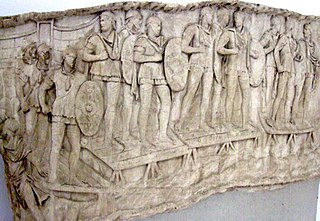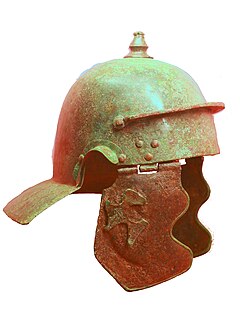
The Auxilia were introduced as non-citizen troops attached to the citizen legions by Augustus after his reorganisation of the Imperial Roman army from 30 BC. By the 2nd century, the Auxilia contained the same number of infantry as the legions and, in addition, provided almost all of the Roman army's cavalry and more specialised troops. The auxilia thus represented three-fifths of Rome's regular land forces at that time. Like their legionary counterparts, auxiliary recruits were mostly volunteers, not conscripts.
Cohors secunda Gallorum veterana equitata was a mixed infantry and cavalry regiment of the Auxilia corps of the Imperial Roman army. It was stationed, in the 2nd and 3rd centuries, in a fort near Hadrian's Wall in Britain.

Cohors quarta Gallorum equitata was a Roman auxiliary cohort containing both infantry and cavalry contingents. It was probably raised in Gallia Lugdunensis at the time of the founder-emperor Augustus. It is first attested in Moesia in 75 AD and was still in Moesia Inferior in 105. It therefore probably took part in the emperor Trajan's Dacian Wars (99-106). After a brief stay in Thracia, it was transferred to Britannia not later than 122. Its last datable attestation is in 276-82, still at Vindolanda. But the Notitia Dignitatum, a late Roman official document, records a cohors IV Gallorum at Vindolanda under the dux Britanniarum, the commander of limitanei along Hadrian's Wall. The Western section of the Notitia was drawn up in the 420's but the British units must date to before 410, when the island was evacuated by the Roman army.
Cohors prima Alpinorum equitata was a Roman auxiliary mixed infantry and cavalry regiment. Alpini was a generic name denoting several Celtic-speaking mountain tribes inhabiting the Alps between Italy and Gaul, which were organised as the Tres Alpes provinces. The regiment was probably raised as one of 4-6 Alpini units recruited after the final annexation of the western Alpine regions by emperor Augustus in 15 BC.
Cohors secunda Alpinorum equitata was a Roman auxiliary (non-citizen) mixed infantry and cavalry regiment. Alpini was a generic name denoting several Celtic-speaking mountain tribes inhabiting the Alps between Italy and Gaul, which were organised as the Tres Alpes provinces.
Cohors tertia Alpinorum equitata was a Roman auxiliary mixed infantry and cavalry regiment. Alpini was a generic name denoting several Celtic-speaking mountain tribes inhabiting the Alps between Italy and Gaul, which were organised as the Tres Alpes provinces.
Cohors prima Raetorum equitata was a Roman auxiliary mixed infantry and cavalry regiment. It is named after the Raeti nation, which dominated the eponymous province Raetia, which comprised much of modern Switzerland and Germany south of the river Danube. The Raeti originally spoke a non Indo-European language closely related to Etruscan. However, by the time their territory was annexed by Rome under founder-emperor Augustus, they had become largely Celtic-speaking through contact with neighbouring peoples such as the Vindelici. Finally, during the centuries of Roman rule, they became Latin speakers: their distinctive provincial patois survives today in the form of the Rhaeto-Romance languages.

Cohors tertia Delmatarum equitata civium Romanorum pia fidelis, was a Roman auxiliary cohort mixed infantry and cavalry unit.
Cohors sexta Delmatarum equitata was a Roman auxiliary mixed infantry and cavalry regiment.
Cohors septima Delmatarum equitata was a Roman auxiliary mixed infantry and cavalry regiment. It is named after the Dalmatae, an Illyrian-speaking tribe that inhabited the Adriatic coastal mountain range of the eponymous Dalmatia. The ancient geographer Strabo describes these mountains as extremely rugged, and the Dalmatae as backward and warlike. He claims that they did not use money long after their neighbours adopted it and that they "made war on the Romans for a long time". He also criticises the Dalmatae, a nation of pastoralists, for turning fertile plains into sheep pasture. Indeed, the name of the tribe itself is believed to mean "shepherds", derived from the Illyrian word delme ("sheep"). The final time this people fought against Rome was in the Illyrian revolt of 6-9 AD. The revolt was started by Dalmatae auxiliary forces and soon spread all over Dalmatia and Pannonia. The resulting war was described by the Roman writer Suetonius as the most difficult faced by Rome since the Punic Wars two centuries earlier. But after the war, the Dalmatae became a loyal and important source of recruits for the Roman army.
Cohors prima Delmatarum milliaria equitata was a Roman auxiliary mixed infantry and cavalry regiment. It was named after, and originally recruited from, the Dalmatae, an Illyrian-speaking people that inhabited the Adriatic coastal mountain range of the eponymous Dalmatia.

This article concerns the Roman auxiliary regiments of the Principate period originally recruited in the western Alpine regions of the empire. The cohortes Alpinorum came from Tres Alpes, the three small Roman provinces of the western Alps, Alpes Maritimae, Alpes Cottiae and Alpes Graiae. The cohortes Ligurum were originally raised from the Ligures people of Alpes Maritimae and Liguria regio of NW Italia.
Cohors PrimÆ Ælia Dacorvm was an infantry regiment of the Auxilia corps of the Imperial Roman army. It was first raised by the Roman emperor Hadrian in the Roman province of Dacia not later than AD 125 and its last surviving record dates c. 400. It was deployed, for virtually its entire history, in forts on Hadrian's Wall on the northern frontier of Britannia province.
Cohors [prima] Batavorum milliaria civium Romanorum pia fidelis was a Roman auxiliary cohort of infantry.
Cohors prima Ulpia Dacorum was an infantry regiment of the Auxilia corps of the Imperial Roman army. It was founded by the Roman emperor Trajan, probably in preparation for his planned war against Parthia (113-6). The regiment's honorific title Ulpia refers to the emperor's gens, or clan-name.

Cohors prima Flavia Canathenorum [sagittaria] [milliaria] was a Roman auxiliary cohort of infantry.
The Cohors I Asturum et Callaecorum was a Roman auxilia unit.
The Cohors II Asturum et Callaecorum [equitata] was a Roman auxiliary unit. It is known from military diplomats and brickwork.
Cohors tertia Ulpia Petraeorum [sagittaria] [milliaria] [equitata] was a Roman auxiliary cohort of infantry and cavalry.
Cohors prima Ulpia Galatarum was a Roman auxiliary cohort of infantry.






